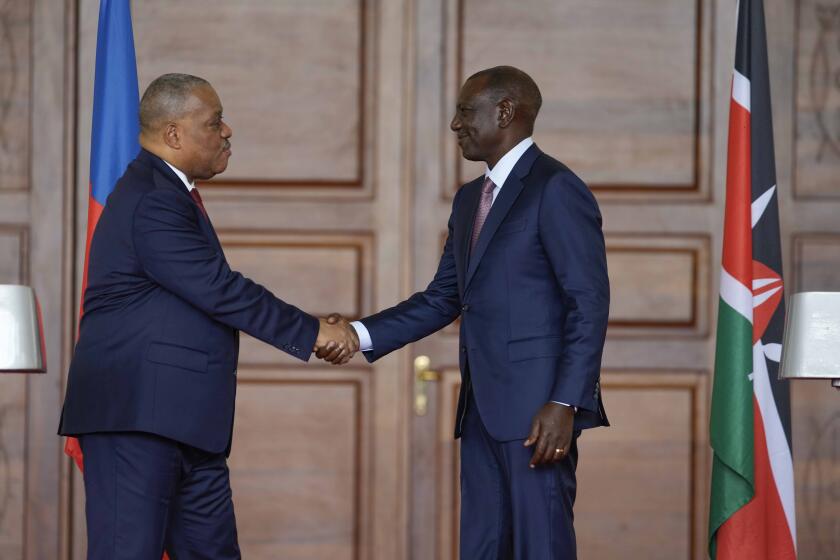POTUS AND THE POSTIES : Clinton’s Media Staff Is Young, Hip and Spin-Savvy, But Do They Understand the Difference Between the Medium and the Message?
THE BOY WITH THE BLOND HAIR SPRAYED INTO SPIKES IS SITTING IN THE PRESIDENT’S chair. He is dressed head to toe in black, as always, down to his chic, rubber-soled Doc Marten shoes. At school they call kids like him “PIBs,” people in black, the artsy types, the ones into new music and art films. Today the boy has added a yellow-and-black tie over his short-sleeve polo shirt--an honor he accords only to the President. For the vice president or First Lady Hillary Rodham Clinton, he goes open collar.
“Can I see a tight shot of the chair?” he says to Richard (Oz) Ouzounian, the vendor he has hired to produce the satellite feed. “Cool,” he says.
Sitting here in the TV studio in the Old Executive Office Building overlooking the White House, he looks as if he wandered off from a White House tour. That is not entirely wrong. At 23, David Anderson is still a student, a history major at Oberlin College in Ohio, finishing his course work at night through correspondence. He is also director of television services for Bill Clinton’s White House.
“Will POTUS be on time?” one of the TV crew asks him. POTUS is the President of the United States.
“No,” Anderson says, peering up through his wire-frame glasses with knowing eyes. POTUS is never on time.
Thomas, a photographer on assignment for the German magazine Tempo who is spending the week following several young staffers for a photo spread, is photographing Anderson’s image on the TV monitor.
Anderson’s eyes move from the camera in front of him to the monitor just to its left as he checks the shot. “Move the presidential seal,” he instructs. His voice is polite and mannered, like that of an honor student.
Eventually, the President arrives, 15 minutes late.
“Hi, how are you?” he says to two strangers at the studio entrance. Bill Clinton in meet-and-greet mode.
“This is my mom,” Anderson tells Clinton, pointing to a woman just inside the room. She is visiting from East Lansing, Mich.
The President puts his arm around the youth with the spiked hair. “He’s a wizard at this stuff,” Clinton says.
“He’s a good son,” Marion Anderson answers proudly.
In a minute, Clinton is in the chair, and Anderson pulls aside Lillian Brown, the White House makeup lady, and whispers in her ear.
“The bags,” he reminds her, referring to Clinton’s eyes. Brown leans over Clinton and begins work on his face, which, after Easter weekend, looks more rested than usual.
“This is supposed to be five minutes,” Clinton says to Anderson, pointing to the speech he is about to deliver. “It looks like a lot more.”
“It’s seven and a half,” Anderson says; he has read it for time.
Clinton is going to talk to defense industry executives in Boston. The briefing is electronic, a function of satellites, fiber-optic wires and political strategies.
“OK. We’re 30 seconds away,” Anderson tells the President.
“I’m not ready,” Brown says.
“Hurry, then,” Anderson tells her. “Twenty seconds.”
Thomas is snapping pictures furiously. The camera’s motor drive annoys Anderson, who points for the photographer to move away. The German obeys.
“Nine, eight, seven,” he counts down. Then he points at the President of the United States.
“Hello,” Clinton says, taking the cue and reading casually from the TelePrompTer. “I want to welcome you to the first of five White House briefings on the technology reinvestment project.”
“You know something odd?” Anderson’s mother whispers to a reporter. “We didn’t even have a television until David was 12. We don’t think much of television in our house.”
ANDERSON, ALSO SWEATING TWO KILLER 30-PAGE PAPERS FOR PROFESSORS THIS semester, is not the only postie (post-baby boomer) with authority in the Clinton White House. In his large, messy office--his mountain bike leans in the corner--Anderson sits across from Richard Strauss, a tall young man with a listening face and quiet manner. Strauss, 23, is a senior at UCLA who withdrew to volunteer for Clinton in New Hampshire. Now he is director of radio for the White House. Like Anderson, he’s trying to graduate at night.
In the office next door is Jess Sarmiento, whose job is to get Bill Clinton’s message to the specialty press--ethnic, minority and trade journals. She is 23. Next to her is Josh Silverman, 25, also in specialty press. Ernie Gibble, who handles regional media in the Northeast, is 27. Kim Hopper, who handles local press for the West, is 27, too.
By one account, 63 of the 450 on the White House staff are younger than 24.
Overseeing all of the 50-person communications staff and strategy is George Stephanopoulos, the stylish Rhodes scholar and heartthrob pictured provocatively in Vanity Fair and People. The former Capitol Hill aide is one of Clinton’s five most-trusted aides. Age 32.
With its thirst for simple metaphors, the press fell in love with the idea of “children” running the White House. During the first 100 days, the media--from Time to the New Yorker--swarmed all over these Techno Brats. A cartoon in the New Orleans Times-Picayune pictured a bunch of kids walking the halls with the caption, “No, this is not the school tour, those are the Clinton staffers.”
Undeniably, the Bush era, with its dress code requiring women to wear skirts or dresses, has given way to open doors, open collars and the sounds of “Front 242” and “Radio Head” coming from the CD player behind Anderson’s desk. “I’m told my taste in music is dark,” Anderson says.
The kids have come to represent a new way of doing things, of the digital Democrats versus the analog Republicans, a symbol that the Clinton White House is revolutionizing communications, bypassing the old media, the national press, in favor of the new media, Larry King, town halls and satellite technology. After 15 weeks in office, Clinton had held only two full-fledged news conferences. Of the past six presidents, only Ronald Reagan held as few. Hillary Rodham Clinton has done four satellite tours, giving dozens of interviews to local TV stations. But she has granted only three interviews that have appeared in the national press. “After Clinton’s victory,” gushed a breathless Sidney Blumenthal last month in the New Yorker, “the national press began to suffer, at least a bit, the painful process known in the business world as disintermediation; that is, eliminating the middleman. What the President seeks is unmediated communication.”
Unmediated communication--something not cut up into nine-second network sound-bites--meant to some people more openness, perhaps something closer to the truth. But the accounts of that revolution are quite simply wrong.
The way the Clinton White House is approaching the press has more to do with the lessons of Richard M. Nixon and Ronald Reagan than the technology of Apple Computer co-founder Steve Jobs or the electronic town hall and direct democracy fantasies of Ross Perot. People may have Apple PowerBooks and the staff may be hipper, but the gravitational laws of political persuasion still apply. The bottom line, as it ever was, is control. And the kids will be the first to admit it.
“All this stuff about us skipping the national media,” Anderson says, “is great. It makes people who want change happy. It makes the local media outlets we are trying to woo happy. And it isn’t true.”
IF THE LOCAL PRESS IS HAPPY, SOME OF THE ELITE WASHINGTON PRESS CORPS seem notably threatened. Sixty-three-year-old David Broder, chief political correspondent of the Washington Post, jokes in speeches now about how after a particularly acrimonious phone call with Stephanopoulos, who is the same age as Broder’s son, he felt like telling the communications director to go to his room.
“As a father of a kid in college,” says another senior print reporter covering the White House, “I find it somewhat off-putting to talk to male White House aides who are wearing earrings. It’s like coming home and finding your kids got into the liquor cabinet.”
During the photo shoot for this article, two senior members of the White House staff stopped as they made their way down the wide marble hallway of the Old Executive Office Building. “Another Young Turks story,” one of them grumbled.
A few feet away sits the office of Jeff Eller, head of media affairs, who is responsible for wooing local media and whose empire includes more young staff than any other. Eller, 37, who answers to Stephanopoulos, hired Anderson, Strauss, Sarmiento and the others.
He cuts the figure well of technological impresario. He often is engaged in two or three tasks simultaneously--answering the phone, watching the news, reading from his computer--a classic child of the video age.
The attention he and his staff are getting will pass, Eller says. So will the idea that the Administration is trying to bypass the old media--the four networks, the big newspapers and news services. The Clinton White House is very concerned with the old media. Thirty million households still tune into the network news each night--the largest single audience in America. The networks are still influenced by the New York Times, Wall Street Journal and Washington Post. Most of the stories on local TV are still voiced over from scripts and footage produced by the networks in New York.
The problem is not that the Clinton Administration is trying to bypass the national press. The problem is that the youth, self-confidence and sometime arrogance of Clinton’s communications team rub many members of the media the wrong way.
FIRST CAME THE BAN. WHEN CLINTON TOOK OFFICE, ELLER ALMOST IMMEDIATELY banned the press from the area next door to the Oval Office, one of the White House press corps’ oldest privileges. Now a reporter must have an escort to see the press secretary, Dee Dee Myers. Many in the media took the “No Fly Zone,” as reporters now call the hallway between the lower and upper press offices where Stephanopoulos and Myers, 31, work, as a sign that the Administration intended to de-emphasize the importance of the elite media.
The change reflected the real goal of Clinton’s communications strategy: control. Before Clinton took office, Stephanopoulos had met with past presidential communications directors and press secretaries, including Michael Deaver, Reagan’s television adviser. “The biggest mistake Richard Nixon made was not Watergate,” Deaver says he told Stephanopoulos. “It was moving the White House press corps in between the private residence and the Oval Office.”
Deaver’s meaning that the press needs to be kept at a distance struck a chord within the Clinton staff. “My discussions with the Clinton people were mostly about how you maintain the focus,” recalls Deaver, who still works in public relations in Washington. “Maintaining the focus is everything. If you don’t set the agenda in this town, others will set it for you. And when the President gives up the agenda, he is lost.”
The Clinton team is interested in the same thing that Nixon and Reagan were. Controlling the agenda. “They have rejected Reaganomics, but they embraced the rest of it, and improved on it,” says David Gergen, director of communications for both President Gerald R. Ford and Reagan and now editor at large for U.S. News & World Report. “It’s like the Japanese, who studied American quality and are now beating our brains out with it.”
After the press protested the restrictions, Stephanopoulos and Myers instituted three briefings a day, two by Myers (though lately she has dropped one) and one by Stephanopoulos--triple the number of briefings by Bush and Reagan’s press secretary, Marlin Fitzwater. But the press corps soon discovered that neither Stephanopoulos nor Myers ever really said anything. “Let’s stop until George is willing to actually answer a question,” Helen Thomas of United Press International, who’s covered the White House for 32 years, said to end a recent briefing.
“Your job on the podium is to do nothing,” Stephanopoulos says about his job. “Unless you decide to, you should not be making any news. You should not be trumping the President. You should not be getting ahead of him.”
It is not bypass. It is control.
The Reagan Administration set up a team that organized a message of the day, a single point that the White House wanted to communicate to the public. That was then part of a message of the week, which was plotted out six weeks at a time. Clinton has the same thing. Director of Planning David Dreyer, 36, and aide Jonathan Prince, 25, are in charge of developing the message of the day, as well as the strategic message. But unlike Deaver and James Baker, Dreyer cut off his ponytail before moving to the White House.
He and Prince also write up the talking points, a daily message that the Administration and the Democratic Party want espoused through every outlet--from senators to mayors and influential party members. After entangling itself over the issue of gays in the military, the Clinton Administration decided to limit its public discussions to four issues, Myers says: economic reform, health-care reform, political (and political finance) reform and national service. The talking points are sent via fax each day so that the party is all working from the same script. “We are the perpetual campaign,” Prince says.
Stay on Message. Discipline and Repetition Are Your Friends. This is the mantra of the political class, the principles of modern campaigning, the principles of governing. Clinton, with all his slick folksiness, is simply adapting these principles to a communications universe that has radically altered since the days of “the Great Communicator.”
The first change is obvious. “Ronald Reagan had to worry about three TV networks and three newspapers--the New York Times, Washington Post and L.A. Times,” says Clinton political adviser Mandy Grunwald, 37. “People now get their news from many more sources.” Everything from CNN to MTV to “Murphy Brown.”
The other is more subtle, but perhaps more important. “Reagan’s treatment of the media changed how the media reacts,” Stephanopoulos says. The press now tries to resist airing photo ops of the sort Reagan’s team staged each day. “We can’t get away with it,” he says. “There is no way we can have an event a day covered. It is impossible.”
So the agenda is controlled in other ways. Stephanopoulos and his aides, for example, work the phones to steer reporters more aggressively than anyone can remember. ABC correspondent Ann Compton recalls the morning early on when Stephanopoulos called her at 6:40 a.m., 20 minutes before ABC’s “Good Morning America,” which was going to interview British Prime Minister John Major, went on the air.
“John Major and Bill Clinton spent the bulk of time (yesterday) talking about the economic plan,” Stephanopoulos told her. “If you ask about the economic plan, you might get some interesting answers.” She did.
“A big part of Dee Dee’s job,” Stephanopoulos says, “is finding out what is on the minds of the national press and how will they process something when we tell them about it.” Briefings twice a day, going to dinners, schmoozing with reporters are how Myers gathers information, perhaps more than to deliver it. Each morning, Myers (whose earlier work included L.A. Mayor Tom Bradley’s losing gubernatorial campaign) tries to predict, based on the morning papers and the networks’ newscasts, what she should expect.
But there is also enormous fear of the press, which insiders say spreads from the President and First Lady. Mrs. Clinton is said to have a particularly deep-seated aversion to the press and Clinton is famous for temper tantrums about stories he doesn’t like. The couple, who talk about wanting a “zone of privacy,” took the unusual step of having their Social Security numbers blacked out when they released their tax returns.
Part of this fear and aggressiveness is why the Clinton White House devotes such tremendous energy to wooing the local media, the specialty press and other often-more-malleable outlets besides the national press. Since the elite media are more skeptical, other ways of communicating become more important. When things were going poorly during Clinton’s first month, the White House held a town meeting in Michigan to break away from the criticism of the press corps. “Otherwise, the press corps’ perspective could determine everything we do,” Stephanopoulos explains. “The press’ perspective is hardly irrelevant, but it is no longer the whole story.”
But even some of Clinton’s political friends who were involved in the campaign but did not join the White House are alarmed at how the new team is operating. “There are no people (in the communciations staff) who worked in government, who really know how this town worked,” says one political professional close to Clinton. “The arrogance is unbelievable. You will be talking to George on the phone and click, he will just hang up on you.” Stephanopoulos has been known to sit curled up in a chair, popping his gum, apparently listening, then suddenly jump up and leave the room, with his assistant coming in and saying: “George has left. I guess your meeting is over.”
“They barely conceal the idea sometimes that they consider the older Democrats around town as losers, the people who have been screwing up the party for the last decade,” says one Washington Democrat.
“Look at how they lost on the stimulus package,” says one senior Capitol Hill aide, referring to Clinton’s economic proposal that was torpedoed in the Senate by a Republican filibuster. “They didn’t really think it through. They didn’t anticipate the Republican opposition and I think that reflected their lack of experience and their naivete.” “They’re not ignoring us,” says one reporter, “they’re dissing us.”
BILL CLINTON’S IMAGE RADIATES ON A GIANT TV SCREEN AT THE FRONT OF THE United States Chamber of Commerce’s main hall in Washington, D.C. It is the day after the defense reinvestment briefing to Boston. The President’s image is beamed off a satellite transponder and down-linked to 2,000 places across the country on the closed-circuit channel of the Department of Education. Six hundred of those locations are in Wal-Mart stores that donate space at night for the joint Chamber of Commerce and Education Department broadcasts. The Chamber of Commerce has donated its sophisticated TV studios for the effort.
Secretary of Education Richard W. Riley is hosting the broadcast, which also features Labor Secretary Robert B. Reich. Riley is terrible on television. His movements and carriage are stiff and unnatural, partly due to a serious back injury. The program, from an entertainment standpoint, is dreadful. The questions to the President, phoned in from 2,000 down-links, involve arcane details about a federal summer jobs program. “This is the most boring garbage I have ever heard,” a reporter from a national newspaper says.
“It doesn’t matter,” Trish Enright, the 26-year-old director of special projects for Jeff Eller, tells him. “These people around the country are really interested. And the President is talking directly to them. Directly to them. “
“I’m leaving anyway,” the national reporter says.
Clinton’s young staff is becoming accustomed to such remarks from the traditional media. “The national press are like a dinosaur,” Eller, head of media affairs, says. “They’re huge and they will be around for another million years.” His staff is more interested in the new media; so it is not surprising that so many of them are of the MTV generation, who see their inexperience as a strength.
Richard Strauss, of Modesto, was a senior at UCLA in January, 1991, when he decided to withdraw from school and head to New Hampshire to volunteer for Clinton. Strauss had worked for the college radio station and in summer jobs in radio, too. Soon he was using his tape recorder to make “actualities”--radio sound-bites--of Clinton events and offering them to radio stations around New Hampshire. By the Michigan primary a month later, he was feeding 50 stations in that state a day.
By summer, Strauss and Eller had set up in Little Rock a toll-free number that could take 1,100 incoming phone calls simultaneously from the nation’s 7,500 local radio stations. Stations that called in could choose from a menu--push 1 for quotes that day from Clinton, 2 for quotes from running mate Al Gore, 3 from a surrogate, 4 for messages in Spanish, 5 for those aimed at African-American radio audiences, 6 for those for college radio stations. The campaign received 200 to 500 calls a day.
Kim Hopper was working campaigns in California, working with a young political consultant named Dee Dee Myers before she went to work for Clinton’s campaign. Now she is the contact for all local print, radio and TV reporters from the West who don’t have Washington bureaus but want to do White House stories.
David Anderson began working in satellite communications when he signed on for a summer job with Steve Rabinowitz, who owned a satellite vending company in Washington. In the winter of 1991, Anderson took a leave from college to work with Rabinowitz for Nebraska Sen. Bob Kerrey’s presidential campaign. When Kerrey folded, they went to work for Clinton, and when Rabinowitz went on the road as Clinton’s press advanceman, Anderson was left handling the satellite tours the campaign did--more than 750 of them from the Republican and Democratic conventions to Election Day.
When they arrived at the White House, Eller and his crew were appalled by most of the equipment they found. The tiny radio studio tucked away on the fourth floor of the Old Executive Office Building was antiquated. The tape deck would only play cassettes recorded on that machine. The phone system was older than that of any modern business. Voice mail was not feasible.
The press seized on these facts. The combination of people so young, waiting to replace the antiquated equipment in the White House so that they could employ their new communications strategies seemed an irresistible metaphor for an energetic Administration about to change the world.
And Eller’s team does have a lot of fresh ideas. Strauss dreams of a system that will automatically call radio stations with a recorded message each day. Anderson’s memos talk about state tele-press conferences, where local reporters around the country could hold their own news conferences with the President via satellite and large-screen projection TV. Eller thinks about the day when every presidential event might be transmitted via satellite--the Bill Clinton channel! Yet all of these ideas work on the margins of communication, not at the center. The primary message delivered through local media is more psychological than informative. “The central strength of Clinton is that people believe he is in touch with them and cares about them,” argues Stephanopoulos. “And talking about local issues to a local anchorman, even if it doesn’t move voters, reinforces the idea that he is in touch.”
But being in touch is more than mass-producing a message, it’s listening to the response that message generates.
AFTER 100 DAYS, IT’S BECOME clear that a communications strategy is not enough. Congress has defeated Clinton’s stimulus package, and the President has been under fire over the ethnic cleansing in Bosnia. The health-care task force is encountering problems, too. And no matter how much the young staff tries to stay focused, to control the agenda, they are working for a President who by nature is complicated, emotional, messy.
Yet Clinton’s communications staff, even in private, seems unwilling to acknowledge even obvious problems, which annoys some Washington insiders. The Clinton crowd may be masters of the new technology, but it’s only a tool. It doesn’t matter if you get your message to all the right people at all the right times if the people don’t like the message.
The signs of stress are beginning to show, even in the satellite sessions.
“Hey, Jack, how are you?” Hillary Rodham Clinton asks the anchorman from KUSA-TV, the ABC affiliate in Denver.
It is two days after Clinton’s defense reinvestment briefing, and the First Lady is doing a seven-city, four-state satellite tour in an hour from the White House studio. Anderson is executive producer.
This is Mrs. Clinton’s fourth satellite tour of local TV anchors since her husband took office. She is selling her health-care reform plan locally, but she is on the defensive most of this hour, deflecting questions about not having doctors or insurance companies on her task force, about raising taxes to pay for the plan, something candidate Clinton said wouldn’t be necessary.
“Isn’t a value added tax inflationary?” demands Joe from KMTV in Omaha.
On the surface, Mrs. Clinton does well, and the young staff is delighted. They seem unmoved by the accusatory tone of the questions. “She was in a great mood,” Anderson says.
But watching, one reporter recalls something George Stephanopoulos said weeks ago, when things were better, about the kids, about the strategy and about the Clinton presidency. “You can’t have the triumph of form over substance,” Stephanopoulos said. “Form has to serve substance.”
In other words, in the end, how the Clinton Administration communicates is less important than what it communicates. “This election is about change,” Clinton said a thousand times during the campaign. But after nearly four months, the promise of change, even a change in technology or generation, is only meaningful stylistically. And so far, that is not enough.
More to Read
Sign up for Essential California
The most important California stories and recommendations in your inbox every morning.
You may occasionally receive promotional content from the Los Angeles Times.










